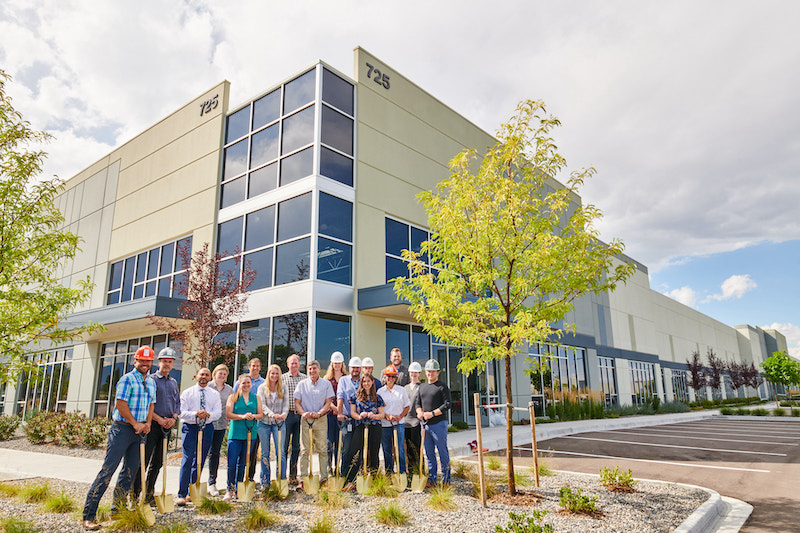Late last month, the startup oncology company Umoja Biopharma and CRB Group, a sustainable AEC and consulting firm, started construction on the fitout of a 146,000-sf building in Louisville, Colo.
CRB, whose practices include Biotech, food and beverage, pharma, and Science + Technology, is transforming the existing building into highly flexible and scalable manufacturing, lab, office, and warehouse space. The design focuses on integrating LEED criteria and zero-carbon emissions to meet Umoja’s sustainability goals. The project is in two phases, and should be completed by October.
What makes this project different is the application of CRB’s ONEsolution delivery approach, where the firm—whose services include architecture, engineering, construction, and consultation—will take the fitout from its initial planning to operational readiness. CRB, with 18 offices in North America and two in Europe, espouses the principles of Integrated Project Delivery, and uses lean construction tools to align stakeholders on all aspects of the project.
ONEsolution is “key” to “creating a collaborative environment” with clients like Umoja, says Colton Konkak, CRB Group’s Colorado Market Team Leader, who spoke with BD+C last week about this project. He explains that the advantages of ONEsolution include early cost and scheduling certainty without any loss of design or construction integrity, “which is important for a startup.”
“Working closely with Umoja demonstrates their commitment to sustainability, diversity, equity, inclusion, creativity, and fast project delivery,” says Konkak. “These commitments and goals unified our team members and allowed us to support rapidly changing technology.”
ITS CAST INCLUDES EXPERT EXTRAS
CRB’s M.O. is to hire industy experts as needed on projects. For example, on the Umoja fitout it brought in three local subs: Impact Mechanical for MEP engineering, Kenny Electric for electrical installation, and HTI Labs for laboratory case workstations. “We aren’t bashful, either, about handing over our documents to other AEC firms, to get a second opinion,” says Konkak.
On certain other projects, CRB is dipping its toe into modularization through its SlateXpace multimodal manufacturing system that provides even greater opportunities for speed to market, cost control, and adaptability. Currently it is working with Germfree, which specializes in providing modular biopharma cleanrooms.
Related Stories
| Nov 2, 2010
Wind Power, Windy City-style
Building-integrated wind turbines lend a futuristic look to a parking structure in Chicago’s trendy River North neighborhood. Only time will tell how much power the wind devices will generate.
| Nov 2, 2010
Energy Analysis No Longer a Luxury
Back in the halcyon days of 2006, energy analysis of building design and performance was a luxury. Sure, many forward-thinking AEC firms ran their designs through services such as Autodesk’s Green Building Studio and IES’s Virtual Environment, and some facility managers used Honeywell’s Energy Manager and other monitoring software. Today, however, knowing exactly how much energy your building will produce and use is survival of the fittest as energy costs and green design requirements demand precision.
| Nov 2, 2010
Yudelson: ‘If It Doesn’t Perform, It Can’t Be Green’
Jerry Yudelson, prolific author and veteran green building expert, challenges Building Teams to think big when it comes to controlling energy use and reducing carbon emissions in buildings.
| Nov 1, 2010
John Pearce: First thing I tell designers: Do your homework!
John Pearce, FAIA, University Architect at Duke University, Durham, N.C., tells BD+C’s Robert Cassidy about the school’s construction plans and sustainability efforts, how to land work at Duke, and why he’s proceeding with caution when it comes to BIM.
| Nov 1, 2010
Vancouver’s former Olympic Village shoots for Gold
The first tenants of the Millennium Water development in Vancouver, B.C., were Olympic athletes competing in the 2010 Winter Games. Now the former Olympic Village, located on a 17-acre brownfield site, is being transformed into a residential neighborhood targeting LEED ND Gold. The buildings are expected to consume 30-70% less energy than comparable structures.
| Oct 27, 2010
Grid-neutral education complex to serve students, community
MVE Institutional designed the Downtown Educational Complex in Oakland, Calif., to serve as an educational facility, community center, and grid-neutral green building. The 123,000-sf complex, now under construction on a 5.5-acre site in the city’s Lake Merritt neighborhood, will be built in two phases, the first expected to be completed in spring 2012 and the second in fall 2014.
| Oct 18, 2010
World’s first zero-carbon city on track in Abu Dhabi
Masdar City, the world’s only zero-carbon city, is on track to be built in Abu Dhabi, with completion expected as early as 2020. Foster + Partners developed the $22 billion city’s master plan, with Adrian Smith + Gordon Gill Architecture, Aedas, and Lava Architects designing buildings for the project’s first phase, which is on track to be ready for occupancy by 2015.
| Oct 13, 2010
Test run on the HP Z200 SFF Good Value in a Small Package
Contributing Editor Jeff Yoders tests a new small-form factor, workstation-class desktop in Hewlett-Packard’s line that combines performance of its minitower machine with a smaller chassis and a lower price.
| Oct 13, 2010
Prefab Trailblazer
The $137 million, 12-story, 500,000-sf Miami Valley Hospital cardiac center, Dayton, Ohio, is the first major hospital project in the U.S. to have made extensive use of prefabricated components in its design and construction.















